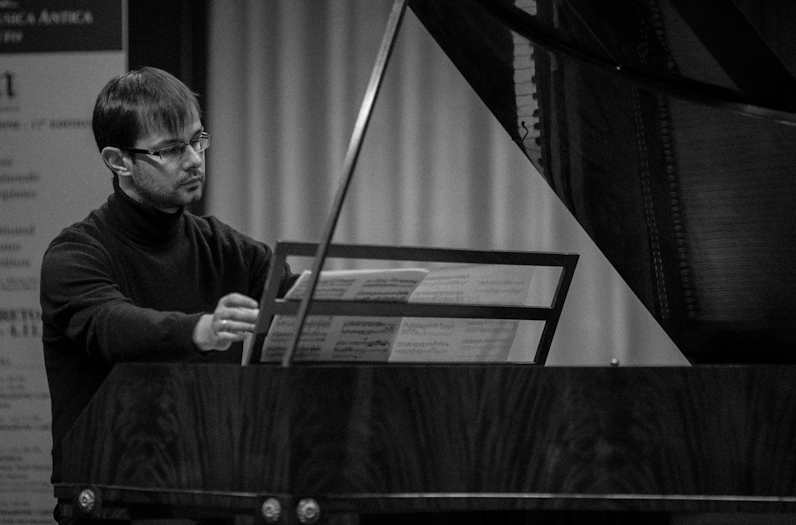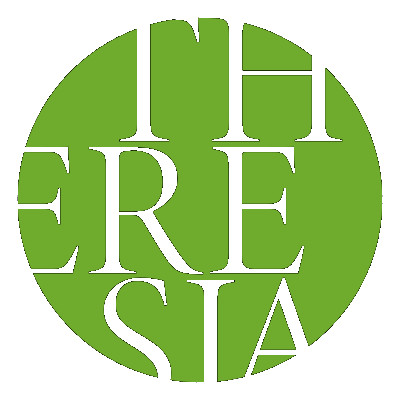
Assen Boyadjiev è il secondo solista che si esibirà con Theresia: lui al fortepiano, Olga Pashchenko al clavicembalo, anche Assen è una conoscenza di Theresia, perché anche lui nel 2012 partecipò al Premio Ferrari aggiudicandosi il Secondo Premio e il Premio Speciale “Theresia” per la miglior esecuzione di un concerto di Mozart. 34 anni, è nato e cresciuto in Bulgaria, ma vive ad Hannover da quando ne aveva 18: “Mi sono trasferito ad Hannover per studiare, e a parte un’esperienza nel 2008 alla Cornwell University dove mi sono perfezionato con Malcolm Bilson, sono sempre rimasto in Germania. Anche dopo aver finito gli studi – l’ultimo diploma l’ho conseguito nel 2010 – sono restato ad Hannover, dove svolgo la mia attività di docente insegnando Prassi esecutive sulle tastiere antiche.”
Quello delle tastiere è un mondo immenso: tu ti sei specializzato in un solo ambito o hai continuato a suonare il pianoforte accanto a clavicembalo e fortepiano?
“Il pianoforte moderno non l’ho abbandonato e lo suono occasionalmente in concerto: ma il mio principale interesse è il fortepiano, ovvero lo strumento antico, in cui mancano quegli accorgimenti tecnici che rendono “moderno” il pianoforte odierno. In questo senso il mio repertorio va fino a Debussy: lui suonava pianoforti Pleyel ed Erard, che non hanno le corde incrociate come gli Steinway. Sono dunque ancora fortepiani, anche se il confine è a quel punto molto sottile. E proprio esplorare questo confine è una cosa che mi appassiona molto.”
Passare dal pianoforte moderno al fortepiano è una questione di tecnica?
“Non necessariamente: piuttosto, è il suono che cambia, proprio per le differenze di costruzione a cui accennavo prima: il colore è diverso, inoltre c’è una differenza nei registri che nel pianoforte moderno invece è sparita a favore di una maggiore omogeneità tra bassi e alti.”
Cosa abbiamo guadagnato e cosa abbiamo perso nel passaggio tra fortepiano e pianoforte?
“La cultura e il gusto cambiano, e così le abitudini: nel Settecento la musica si faceva in piccole sale, e il volume ridotto del fortepiano non era un problema. Ma oggi le sale da concerto sono immense, e naturalmente gli organizzatori vogliono riempirle. Pensiamo alla Carnegie Hall: certo gli ascoltatori delle ultime file non potrebbero cogliere tutte le finezze del suono del fortepiano. A me piace fare questo esempio: un pianoforte moderno è come una grande berlina tedesca, perfetta per andare veloci e sicuri su un’autostrada: ma se si deve guidare nei vicoli di Palermo? Diventa ingombrante, rischiamo di graffiarla, restiamo bloccati e questo stress rovina il piacere di tutti i dettagli che ci circondano. Se andiamo a cavallo, invece, si va molto più piano ma ci si gode il viaggio. E per cambiare ancora metafora, la musica di Mozart è come l’architettura di una città settecentesca: suonarla sul pianoforte moderno significa accettare continui compromessi.”
Parliamo del Concerto di CPE Bach: l’avevi mai suonato prima?
“No, e sono molto contento di questa occasione: il Doppio Concerto è stata la composizione più popolare di CPE Bach, perché è una musica speciale e spettacolare, che mette insieme i due strumenti esaltandone le caratteristiche: ci sono infatti molti passaggi nella parte di Olga in cui lo stile barocco del clavicembalo caratterizza la scrittura. Se ci scambiassimo le parti e io suonassi la sua al fortepiano, e viceversa, questo farebbe perdere il sapore speciale della musica.”
Com’è il lavoro in questi giorni con Theresia?
“Mi trovo molto bene, i musicisti dell’orchestra sono molto veloci a reagire alle sollecitazioni di Chiara Banchini, che peraltro è anche molto aperta ai nostri commenti, alle nostre proposte. Credo che per l’orchestra questo concerto sia ancora più difficile che per i due solisti: certi passaggi sono perfetti per la tastiera, molto più scomodi se li si suona con il violino. Inoltre Bach chiede elettricità all’orchestra fin dalle prime note.”
English translation by: Charlotte Michi
Assen Boyadjiev is the second soloist that played with Theresia this summer: he played the fortepiano, Olga Pashchenko the harpsichord. Also Assen is an acquaintance of Theresia, he took part at the Premio Ferrari in 2012, winning the Second Place and the “Theresia” Special Price for the best performance of a concert written by Mozart. 34 years, he was born and grew up in Bulgaria but lives in Hannover since the age of 18: “I moved to Hannover to study, and except for an experience at the Cornwell University in 2008, where I specialized with Malcolm Bilson, I have always been in Germany. Even after finishing my studies – I obtained the last degree in 2010 – I remained in Hannover, where I teach performance practices on early keyboards.”
The keyboard world is immense: you have specialized in one field or you continue to play the piano beside the harpsichord and the fortepiano?
“I never abandoned the modern piano and sometimes I still play it in concert: but my primary interest is the fortepiano, the early instrument, in which all those technical features that make “modern” today’s piano are lacking. In this sense my repertoire ranges up to Debussy: he played Pleyel and Erard pianos, that have no crossed strings like Steinway. Thus they are still fortepianos, even if the boundary is very thin. Exploring this border is something that fascinates me a lot.”
To switch from the modern piano to the fortepiano is a matter of technique?
“Not necessarily: it’s rather the sound that changes, due to the construction differences I mentioned before: the color is different, also there is a difference in the registers that in the modern piano disappeared for the benefit of a greater consistency between high notes and low notes.”
What have we gained and what have we lost in the transition from fortepiano to pianoforte?
“Culture and taste change, and so do habits: in the eighteenth century music was performed in small rooms, and the low volume of the fortepiano was not a problem. But today concert halls are immense, and obviously the organizers want to fill them. If we think of the Carnegie Hall: of course listeners of the last rows can not grasp the subtleties of the sound of fortepiano. I like to do this example: a modern piano is like a big red German sedan, perfect to drive fast and safe on the highway: but what if we have to drive in the alleys of Palermo? The car becomes cumbersome, the risk of scratching it is high, we get stuck and this stress ruins the pleasure of observing all the details that surround us. If we go on horseback, instead, we go slower but we enjoy the trip. To change metaphor, the music of Mozart is like the architecture of an eighteenth-century city: playing it on the piano means you have to accept continuous compromises.”
Let’s talk about CPE Bach’s Concert: have you ever played it before?
“No, and I am very glad for this opportunity: the Double Concerto has been the most popular composition of CPE Bach, because it’s special and spectacular music, that puts together the two instruments highlighting their features: there are many passages in Olga’s part where the baroque style of the harpsichord features the writing. If we switched the parts and I played hers on the fortepiano, and vice versa, we would loose the special flavor of the music.”
How is it working with Theresia?
“I feel very comfortable, musicians react very fast to the solicitations of Chiara Banchini, which is very open to our comments, to our proposals. I think that this concert is even more difficult for the orchestra than for the soloists: some passages are perfect for the keyboard but much more uncomfortable if played on the violin. What is more Bach asks electricity to the orchestra from the very first notes.”


